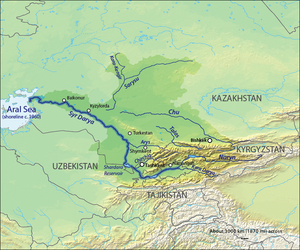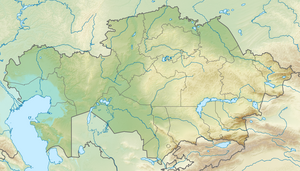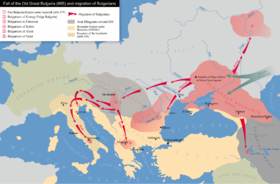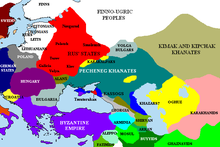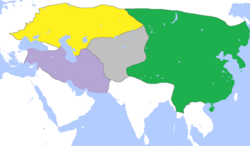
Kazakhstan, the largest country fully within the Eurasian Steppe, has been a historical crossroads and home to numerous different peoples, states and empires throughout history. Throughout history, peoples on the territory of modern Kazakhstan had nomadic lifestyle, which developed and influenced Kazakh culture.

The history of Turkmenistan traditionally began with the arrival of Indo-European Iranian tribes around 2000 BC. Early tribes were nomadic or semi-nomadic due to the arid conditions of the region, preventing widespread adoption of agriculture. The steppe culture in Central Asia was an extension of a larger Eurasian series of horse cultures which spanned the entire spectrum of language families, including the Indo-Europeans and Turko-Mongol groups. Some of the known early Iranian tribes included the Massagatae, the Scythians/Sakas, and early Soghdians, who were most likely precursors of the Khwarezmians. Turkmenistan was a passing point for numerous migrations and invasions by tribes, which gravitated towards the settled regions of the south, including ancient Mesopotamia, Elam, and the Indus Valley civilization.

The Turkic peoples are a collection of diverse ethnic groups of West, Central, East, and North Asia as well as parts of Europe, who speak Turkic languages.
The Kara-Khanid Khanate, also known as the Karakhanids, Qarakhanids, Ilek Khanids or the Afrasiabids, was a Karluk Turkic khanate that ruled Central Asia from the 9th to the early 13th century. The dynastic names of Karakhanids and Ilek Khanids refer to royal titles with Kara Khagan being the most important Turkic title up until the end of the dynasty.

The Oghuz Turks were a western Turkic people who spoke the Oghuz branch of the Turkic language family. In the 8th century, they formed a tribal confederation conventionally named the Oghuz Yabgu State in Central Asia. Today, much of the populations of Turkey, Azerbaijan and Turkmenistan are descendants of Oghuz Turks. Byzantine sources call them Uzes. The term Oghuz was gradually supplanted by the terms Turkmen and Turcoman by 13th century.
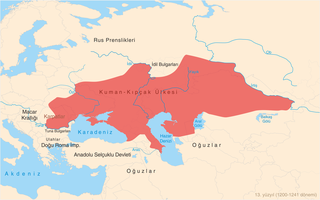
The Kipchaks or Qipchaks, also known as Kipchak Turks or Polovtsians, were Turkic nomads and then a confederation that existed in the Middle Ages inhabiting parts of the Eurasian Steppe.

The Yemek or Kimek were a Turkic tribe constituting the Kimek-Kipchak confederation, whose other six constituent tribes, according to Abu Said Gardizi, were the Imur, Tatars, Bayandur, Kipchaks, Lanikaz, and Ajlad.

The Kimek–Kipchak confederation was a medieval Turkic state formed by seven peoples, including the Yemeks and Kipchaks, in the area between the Ob and Irtysh rivers.
The Karluks were a prominent nomadic Turkic tribal confederacy residing in the regions of Kara-Irtysh and the Tarbagatai Mountains west of the Altay Mountains in Central Asia. Karluks gave their name to the distinct Karluk group of the Turkic languages, which also includes the Uzbek, Uyghur and Ili Turki languages.
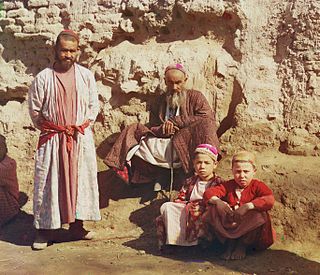
Sart is a name for the settled inhabitants of Central Asia which has had shifting meanings over the centuries.
A khanate or khaganate is the name for a type of historic polity ruled by a khan, khagan, khatun, or khanum. Khanates were typically nomadic Turkic, Mongol and Tatar societies located on the Eurasian Steppe, politically equivalent in status to kinship-based chiefdoms and feudal monarchies. Khanates and khaganates were organised tribally, where leaders gained power on the support and loyalty of their warrior subjects, gaining tribute from subordinates as realm funding. In comparison to a khanate, a khaganate, the realm of a khagan, was a large nomadic state maintaining subjugation over numerous smaller khanates. The title of khagan, translating as "Khan of the Khans", roughly corresponds in status to that of an emperor.
The Turkic migrations were the spread of Turkic tribes and Turkic languages across Eurasia between the 6th and 11th centuries. In the 6th century, the Göktürks overthrew the Rouran Khaganate in what is now Mongolia and expanded in all directions, spreading Turkic culture throughout the Eurasian steppes. Although Göktürk empires came to an end in the 8th century, they were succeeded by numerous Turkic empires such as the Uyghur Khaganate, Kara-Khanid Khanate, Khazars, and the Cumans. Some Turks eventually settled down into sedentary societies such as the Qocho and Ganzhou Uyghurs. The Seljuq dynasty settled in Anatolia starting in the 11th century, resulting in permanent Turkic settlement and presence there. Modern nations with large Turkic populations include Kyrgyzstan, Turkmenistan, Turkey, Azerbaijan, Uzbekistan and Kazakhstan, and Turkic populations also exist within other nations, such as Chuvashia, Bashkortostan, Tatarstan and the Sakha Republic of Siberia in Russia, Northern Cyprus, the Crimean Tatars, the Kazakhs in Mongolia, the Uyghurs in China, and the Azeris in Iran.

The Eurasian Steppe, also called the Great Steppe or The Steppes, is the vast steppe ecoregion of Eurasia in the temperate grasslands, savannas and shrublands biome. It stretches through Hungary, Bulgaria, Romania, Moldova, Ukraine, southern Russia, Kazakhstan, Xinjiang, Mongolia and Manchuria, with one major exclave, the Pannonian steppe, located mostly in Hungary.

The Oghuz Yabgu State or Oghuz Il was a Turkic state, founded by Oghuz Turks in 766, located geographically in an area between the coasts of the Caspian and Aral Seas. Oghuz tribes occupied a vast territory in Kazakhstan along the Irgiz, Yaik, Emba, and Uil rivers, the Aral Sea area, the Syr Darya valley, the foothills of the Karatau Mountains in Tien-Shan, and the Chui River valley. The Oghuz political association developed in the 9th and 10th centuries in the basin of the middle and lower course of the Syr Darya and adjoining the modern western Kazakhstan steppes.
The Kangly were a Turkic people of Eurasia who were active from the Tang dynasty up to the Mongol Empire and Yuan dynasty.

Below is the list of Kazakhstan-related articles.

This article summarizes the History of the eastern steppe, the eastern third of the Eurasian Steppe, that is, the grasslands of Mongolia and northern China. It is a companion to History of the central steppe and History of the western steppe. Most of its recorded history deals with conflicts between the Han Chinese and the steppe nomads. Most of the sources are Chinese.

This article summarizes the History of the western steppe, which is the western third of the Eurasian steppe, that is, the grasslands of Ukraine and southern Russia. It is intended as a summary and an index to the more-detailed linked articles. It is a companion to History of the central steppe and History of the eastern steppe. All dates are approximate since there are few exact starting and ending dates. This summary article does not list the uncertainties, which are many. For these, see the linked articles.

Turkic history is the systematic documentation and study of events involving the Turkic peoples.
